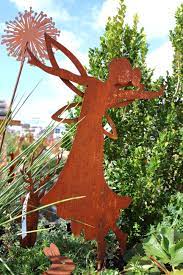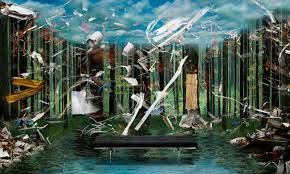Environmental art is a powerful movement that transforms our relationship with nature, often turning landscapes into captivating canvases.
It’s where creativity meets conservation, challenging us to see the environment through a lens of sustainability and beauty.
In this article, we’ll explore the origins, significance, and impact of environmental art, revealing how artists are shaping the dialogue on ecological issues.
Get ready to discover art that doesn’t just sit in galleries—it interacts with the world around us, inspiring change and reflection.
Origins Of Environmental Art
Our fascination with environmental art takes us back to the late 1960s and early 1970s.
It was a period marked by a growing awareness of ecological issues, which coincided with the rise of the modern environmental movement.
Artists began to respond to the changing attitudes toward nature and the increasing concerns about human impact on the earth.
Land Art, with iconic works like Robert Smithson’s Spiral Jetty, emerged as one of the movement’s groundbreaking expressions, blurring the line between art and the natural world.
This era also witnessed a surge in art forms that challenged the confines of traditional gallery spaces.
Earthworks, such as Michael Heizer’s Double Negative, were created in situ – the natural environment being not just the canvas, but a part of the artwork itself.
These pieces were often large-scale, requiring the audience to engage with the site, not just visually but physically.
- Public awareness – Art became a medium to highlight environmental concerns,
- Intervention in natural settings – Artworks were placed or created outdoors,
- Engagement with the land – Art required interaction with the natural environment.
As environmental art continued to evolve, artists incorporated sustainable practices, focusing on themes like:

- Reclamation of industrial sites,
- Biodiversity and conservation,
- Political activism through ecological art installations.
Environmental art is not just about the message it conveys but also about the materials used and the processes involved.
We see a shift towards using eco-friendly, biodegradable materials, and low-impact methods.

In the contemporary scene, artists like Andy Goldsworthy, with works like Rivers and Tides, emphasize the transient nature of art, reflecting the ephemeral qualities of life and the natural world.
By intertwining ecological elements with artistic expression, we discover that environmental art is as much about creating as it is about preserving.

The evolution of this movement continues to inspire and educate, fostering a profound respect for our planet through the lens of creativity.
Definition And Significance
Environmental art is a multifaceted genre that intertwines ecological concerns with artistic expression.
At its core, environmental art seeks to deepen our relationship with the natural world, often posing pressing questions about sustainability and conservation.
This art form manifests in various expressions – from installations that transform landscapes to sculptures made with recycled materials.
Works like Spiral Jetty by Robert Smithson and Running Fence by Christo and Jeanne-Claude are not only captivating visually but also serve as provocative dialogues between humanity and nature.
- Purpose – Environmental art aims to: – Ignite conversations about ecological impacts – Promote environmental awareness – Inspire action towards sustainability.
The significance of environmental art can’t be overstated; it’s a powerful catalyst for change.
By integrating art with nature, artists provide a unique perspective on the environment, inviting viewers to see the world through a lens of stewardship and responsibility.
The Role Of Artists In Environmental Conservation
Artists play a crucial part in highlighting and addressing environmental issues.
Through their work, they raise awareness and evoke emotional responses that can lead to action.
They are not just observers but active participants in the discourse on conservation.
One of the most profound ways artists contribute to environmental protection is by creating works that visualize the unseen and the future implications of current practices.
Installations like Ice Watch, where massive blocks of glacial ice were displayed in public spaces, served as a stark reminder of the rapidly melting Arctic ice.
- Art as Awareness – Artists create pieces that reflect human impact on the environment,
- Art as Activism – Many use their work to protest against environmental degradation,
- Art as Education – Artistic endeavors offer ways to learn about and understand complex ecological issues.
Besides, artists collaborate with scientists, policymakers, and communities to create art that’s both visually compelling and scientifically accurate.
Such collaborations ensure that environmental art resonates with both the heart and the mind, making the invisible impacts of climate change visible and understandable to a broader audience.
Filmmakers, for instance, play a unique role by producing documentaries that capture the severity of environmental crises.
Films like An Inconvenient Truth have an unparalleled power to communicate to global audiences, So mobilizing public opinion in favor of sustainable practices.
Crafting experiences that are immersive and impactful, artists Use an array of traditional and new media to reach diverse audiences.
With the rise of digital platforms, environmental art can now reach beyond the physical world, engaging audiences online and sparking conversations across borders.
Environmental Art And Activism
Environmental art isn’t just about creating aesthetically pleasing objects.
It’s become a crucial vehicle for activism.
Artists Use their unique talents to engage the public, provoke discussions, and inspire action About the preservation and conservation of our natural environment.
One significant way environmental art serves activism is through installation projects.
These often serve as tactical interventions in public spaces, attracting attention to local environmental issues.
Running Fence by Christo and Jeanne-Claude didn’t just transform the landscape aesthetically; it prompted dialogue about land rights and the human intervention in rural spaces.
We also see environmental concerns brought to light through film and digital media.
By harnessing the power of moving images, filmmakers can depict the rapidly changing environmental conditions with fervent clarity.
Films like An Inconvenient Truth have successfully raised public awareness about the challenges of climate change, urging audiences to take action.
Activist art isn’t restricted to outdoor or large-scale public projects – it thrives online too.
Digital platforms serve as a new frontier for ecological art, reaching global audiences with:
- Interactive installations – Virtual reality experiences – social media campaigns.
On these platforms, we’re witnessing a convergence of art, technology, and activism that’s never been seen before.
Digital environmental art is not only about representation; it’s about engaging audiences to participate in a broader environmental movement, turning passive viewers into active participants.
Impact And Benefits Of Environmental Art
Environmental art has an extensive reach, influencing not only the realm of esthetics but also impacting environmental consciousness at large.
This form of art acts as a catalyst for communal discussion and plays a pivotal role in fostering an understanding of ecological issues.
- Creating a bridge between society and nature, this genre encourages active engagement with the environment. – The concepts of regeneration, sustainability, and ecological balance are often at the core of such works, allowing for a transformative experience that goes beyond the visual elements.
Artists utilizing outdoor spaces for installations or Earthworks often opt for materials that have minimal ecological footprints.
These practices promote the sustainable sourcing of materials and emphasize the need for using non-toxic and environmentally friendly alternatives.
- Spiral Jetty, created by Robert Smithson, not only uses the natural landscape as its backdrop but also invites viewers to contemplate the intersection of human activity and the environment.
- Sun Tunnels by Nancy Holt frames the changing patterns of the sun, reflecting the impermanence and fluidity intrinsic within the natural world.
In the cinematic realm, films have the power to communicate environmental narratives on an intimate level, reaching a wide audience and thereby raising awareness.
Engaging stories combined with compelling visual narratives capture the imagination and provoke thought among viewers.
Digital media offers impactful ways to share these experiences globally – where immersive content like virtual reality can bring the plight of a distant rainforest directly to the viewer, irrespective of their physical location.
- Innovative digital platforms Help real-time interactions with environmental issues.
- Through interactive documentaries and film, viewers are not just passive consumers but are also given the tools to become active participants in conservation efforts.
By introducing these ecological concepts through creative mediums, environmental art enables a deeper connection to the issues at hand and fosters a shared sense of responsibility towards our planet’s future.
What Is Environmental Art – Wrap Up
We’ve seen how environmental art serves as a vital bridge between society and ecological awareness.
It’s clear that through creativity and innovation, artists are making a significant impact on the way we perceive and interact with our natural surroundings.
By engaging with this art form, we’re not just appreciating aesthetic value but also committing to a more sustainable and conscious future.
Let’s continue to support and celebrate these meaningful expressions of care for our planet—they’re more than just art; they’re a call to action for us all.
Frequently Asked Questions
What Is Environmental Art?
Environmental art is a creative movement that seeks to improve our relationship with the natural world through aesthetically engaging works that promote awareness of ecological issues.
How Does Environmental Art Benefit Society?
It fosters an understanding of ecological issues, encourages active engagement, and inspires a sense of shared responsibility for environmental conservation.
Can Environmental Art Involve Digital Media?
Yes, environmental art can include films and digital media, which are powerful tools in communicating messages and engaging viewers in environmental issues.
Do Environmental Artworks Use Sustainable Practices?
Environmental artists often emphasize sustainable practices by using eco-friendly materials and creating outdoor installations that harmonize with nature.
How Does Environmental Art Impact Our Connection To Ecological Concepts?
By experiencing environmental art, individuals can form a deeper emotional and intellectual connection to ecological concepts, promoting a greater appreciation of our natural world.


